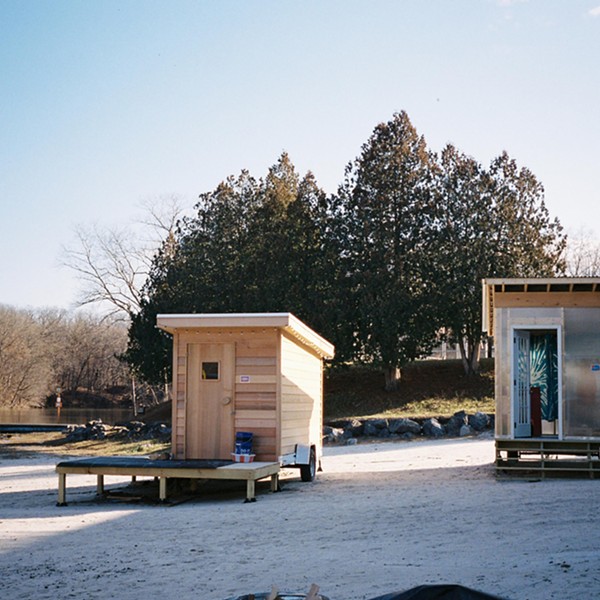I marveled at the harbor activity. Immense tugs and barges passed us. Their closeness defied perception and they looked like huge Broadway sets, brilliantly colorful against the gray morning, carrying cars, trucks, and whatever else, northward.
On the first day, from Albany to New Baltimore, six mature bald eagles were spotted. Their white heads glistened among the dense green that lines the Hudson’s shores. Fellow paddlers take pictures, share binoculars. The eagles are actually offspring from an innovative 1976 experiment, undertaken when only one pair of bald eagles remained on the Hudson. Although the pesticide DDT was banned in the state in 1971, the chemical’s impact was still undermining the environment. Because it becomes concentrated in the food chain, DDT was profoundly affecting birds of prey, causing the thinning of eggs produced by the parent birds. In an innovative experiment, scientists traded the last pair’s corroded, DDT-poisoned eggs with fake eggs, replacing them in the nest at hatching time with tiny eaglets, which the adult birds raised. At the same time, other eaglets were placed in abandoned nests. Although the tiny birds were initially fed and cared for by humans, they ultimately survived on their own. It’s the first time human intervention has successfully brought back a species. Now, up to 80 pairs of eagles nest in the state.
On that first day the tide, complemented by heavy rains a week earlier, was in our favor, and we reached our evening destination, New Baltimore’s Cornell Park, by 1:30pm. I was pleasantly shocked that after 15 miles my arms were still moving and no individual muscle group was shrieking for Ben-Gay.
This shoreline park, like the others we descended upon, was quickly transformed when kayaks were pulled onto land and a variety of colorful tents popped up. Portable toilets had already been placed in the parking lot, and vans shuttled us to a nearby boathouse for showers. We eagerly anticipated dinner.
Although the trip had many delicious catered meals and fine restaurant visits, nothing compared to the delightful barbecue hosted by the New Baltimore Land Conservancy at member John Wallner’s home. As we walked through the streets, people stopped to welcome us. In the yard, musicians played and we were given first dibs on the food before the locals, who had come out to celebrate our journey with us. Under normal circumstances, our gluttony would have embarrassed us. Instead, we reveled in it and eagerly went for seconds on Saratoga ice cream.
This magical evening came to intimately illustrate all the past and the potential of the Hudson, what life must have been like before the Thruway existed, when the river was the heart of the area and neighbors welcomed waterway travelers. From the first Native Americans welcoming the fur traders to Henry Hudson’s exploratory journey almost 400 years ago, even to a modern-day kayak trip, the river unifies people.
The river that flows both ways
The Hudson starts as tiny droplets in the Adirondack Mountains, grows into a trickling stream that emerges from Lake Tear of the Clouds, and ultimately flows into the bustling New York Harbor.
It travels along an ancient path created by glaciers, tectonic crashes, and the uplifting of mountains, holds both fresh and saltwater, and is affected by tides, hence the name given it by the Mohicans: Muhheakunnuk, or “the river that flows both ways.”
It has taken hundreds of millions of years for the Hudson to reach its current status, says William Kelly, head of the New York State Geological Survey.
“In large sense, the geology from the river is a confluence of two worlds that come together.” The rocky peaks on the east side, the Taconic Range, are about 500 million years old, he explains, while those on the west bank, the Catskills, are “only” 320 million years old.
“We think there are two separate mountain-building periods,” he says. “What is known for certain is that the faults created low and valley like conditions.” But for millions of years there was no river formation or connection to the Atlantic Ocean. A solid land mass existed until about 120 million years ago, when the Atlantic opened up along what is now the East Coast. This geological shift slowly created a drainage system that allowed the river valley to develop about 100 million years ago. “The Hudson Highlands might have blocked things up for a while, Kelly says, “but eventually they eroded and the drainage continued southward.”
















